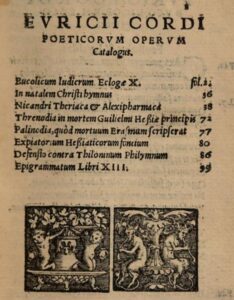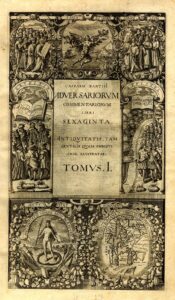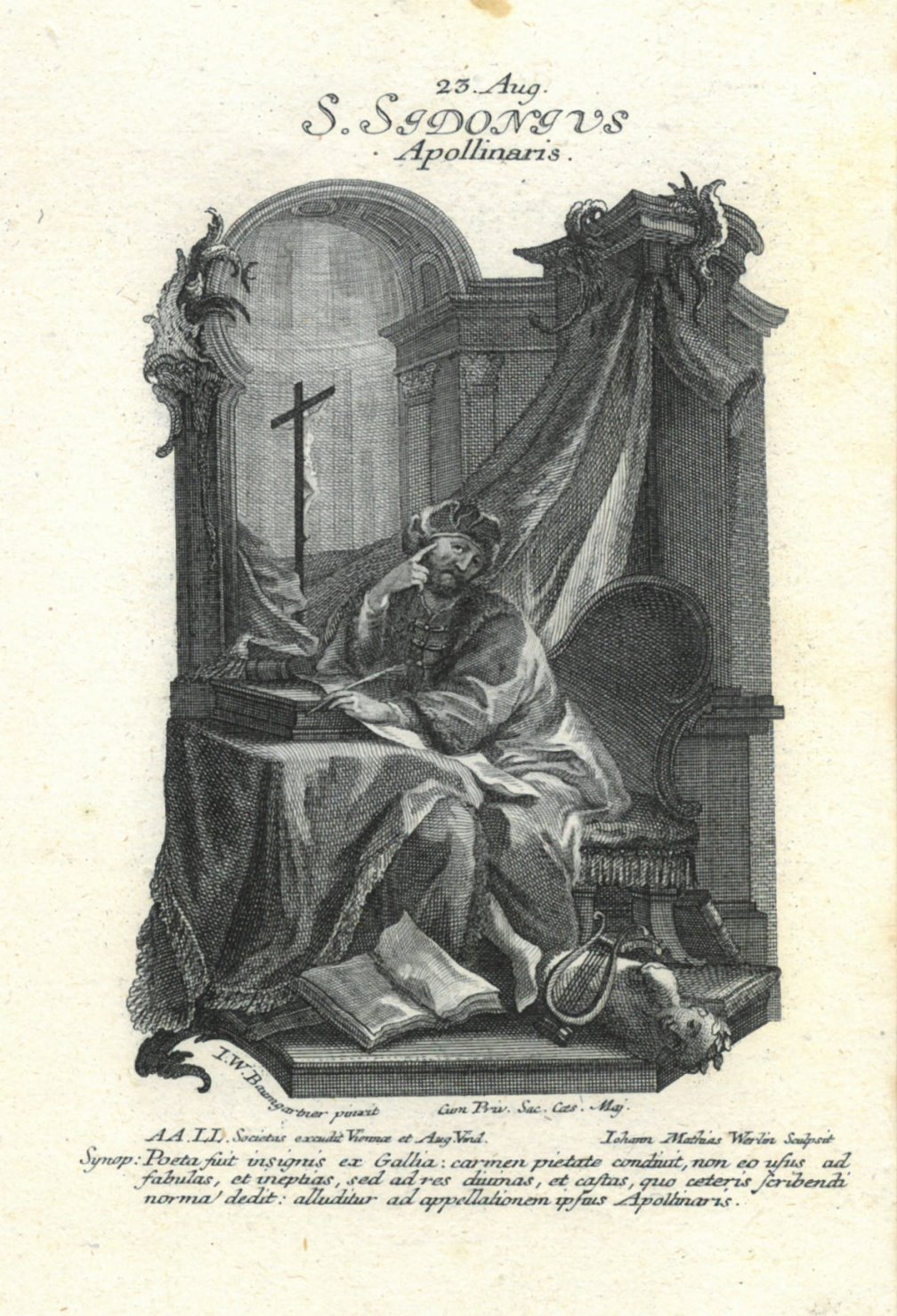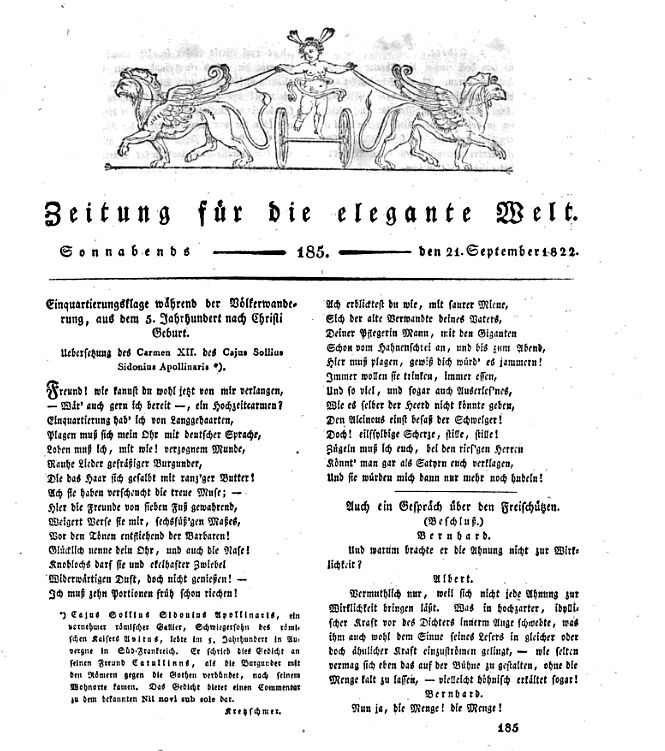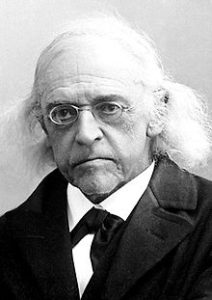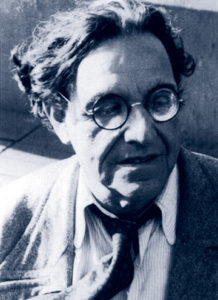Reception in Germany, Austria, and Switzerland
For his ‘Ad librum’, physician, botanist and poet Euricius Cordus (Heinrich Ritze, 1486 Hessen-1535 Bremen) was inspired by Sidonius’ famous envoi ‘Propempticon ad libellum’ (Carm. 24), up to its Phalaecian hendecasyllables, providing it with overtones of Catullus and Martial:
Ad librum
Non praeceps adeo ruas, libelle,
quin tuum prius audias parentem,
quae mandata tibi det exeunti.
Omnes quotquot ubique litteratos
cultoresque novem vides sororum,
meo nomine plurimum saluta.
Et si dignus eis videbor, ut me
antiquae numero sodalitatis,
extremum licet, adnotent, precare.
Dehinc ut rhinocerotas atque barros,
ronchos, auriculas ciconiasque
unius facias pili memento.
Demum quam potes eminus proculque
declines, fugias, abomineris
tectos tetrico hypocritas cucullo
rugosamque senum severitatem
et tantum placitos sibi sophastros,
invisum Latiis genus camenis.
Hoc est quod volui, osculare patrem
aeternumque vale, miselle fili.
After P. Heuzé (ed.), Anthologie bilingue de la poésie latine, Paris: Gallimard, 2020, p. 1344. For a discussion, see Astrid Sänger, ‘Gegner, Gönner und Gelehrte. Studien zu den Epigrammatum libri IX (1529) des humanistischen Dichters Euricius Cordus (1486-1535)’, diss. Hamburg, 2016, 74-83 online
In his prolific Adversariorum Commentariorum libri LX, the humanist Caspar von Barth (Saxony, 1587-1658), touches upon Sidonius in the following places:
17.10: Carm. 2.24-26; 2.117
28.7: Carm. 2.1-2; 2.8-10
47.9: Ep. 1.1.1-2 (Cicero is dismissed for his weepy correspondence!)
49.18: Carm. 7.449; 34.47 (scansion of stipendium/-ialis, long/short i)
54.8: Ep. 2.13 (Damocles); Carm. 23.84-87; 23.91-96; 23.133-38
57.11: Carm. 2.3-4; 2.4-5; 2.53-54; 2.147-48; 2.219 (rhythmical prose, silly sound effects)
58.10: Carm. 2.407-408
In the German Baroque, Sidonius surfaces briefly on a number of occasions, as, for instance, in literary criticism and in a women’s lexicon. See the following three entries:
Daniel Georg Morhof, Unterricht von der Teutschen Sprache und Poesie, Kiel, 1682, 560-61:
Nachgehends hat man diese springende Wörtermaaß noch vielmehr beliebt / wie der Sidonius Apollinaris gethan / biß man gar auff die ομοιοτέλευτα zu Teutsch genante Reime gekommen.
Read online
Johann Christoph Gottsched, Versuch einer Critischen Dichtkunst vor die Deutschen, Leipzig, 1730, 288-89:
Sein [a historian’s] Zweck iſt die nackte Wahrheit zu ſagen, das iſt, die Begebenheiten, ſo ſich zugetragen haben, ohne allen Firniß, ohne alle Schmincke zu erzehlen. Thäte er das nicht, ſo würden ſeine Leſer nicht wiſſen ob ſie ihm glauben ſollten, oder nicht. […] Das iſt das Urtheil ſo man vom Curtius mit Grunde zu fällen pflegt. Man traut ſeinen Nachrichten nicht; weil ſie gar zu ſchön klingen. Florus hat es noch ärger gemacht. Seneca, Apulejus, Sidonius Apollinaris, Martianus Capella, Tertullianus sind unter den ältern; Barclajus aber und unzehliche andre, die in lebendigen Sprachen auch in neuern Zeiten geschrieben, unter diejenigen gezehlet worden, die nicht nur poetisch, sondern gantz hochtrabend, schwülstig, ja unsinnig gedacht und geschrieben haben.
Read online
Gottlieb Siegmund Corvinus, Nutzbares, galantes und curiöses Frauenzimmer-Lexicon, Leipzig, 1715, 70 s.v. ‘Argentaria Polla’:
Nach dem Tode ihres Lucani, dem der Tyranne Nero die Adern ſchlagen lieſſe, ſoll ſie ſich, wie einige wollen, an den Statium verheyrathet haben. Sidonius Apollinaris scheinet darauf zu zielen. Vid. Carm. XXIII [vv. 165-66].
Read online
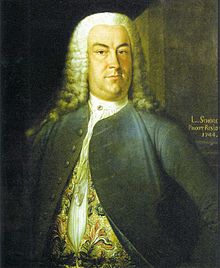
The Austrian born German artist Johann Wolfgang Baumgartner (1702 Kufstein – 1761 Augsburg), one of the most outstanding representatives of Augsburg’s heyday of rococo art, contributed up to 280 oil sketches of patron saints for the illustration of a calendar for daily devotion, ‘Die tägliche Erbauung eines wahren Christen’ (Vienna and Augsburg 1 1753-55, 2 1762/63), an illustrated translation and adaptation of Giovanni Battista Mascolo’s Encomia coelitum (volume 3, July-September, online here).
On the huge production of similar calendar sets of saints and other devotional prints in Augsburg, see G.A. Bailey, The Spiritual Rococo, Ashgate: Farnham, 2014, 124. For Baumgartner’s contribution to ‘Die tägliche Erbauung …’, see the catalogue of the 2009 Baumgartner exposition in Salzburg, Josef Straßer, Johann Wolfgang Baumgartner. 1702-1761. Ölskizzen und Hinterglasbilder. See also Hubert Hosch’s notes on the exposition and Pia-Maria Baurek’s MA thesis on Baumgartner’s colleague in the undertaking, Franz Sigrist.
The saint for 23 August is Sidonius Apollinaris (p. 705-706). He is depicted as an ecclesiastic at his desk in front of a cross; next to him on the floor are a lyre and an overturned bust of Apollo (?) with a laurel wreath. The text is the original Latin one by Mascolo (for an explanation, see Reception Italy). The engraving was done by Johann Mathias Werlin. For more on this engraving, see Joop van Waarden, ‘Sidonius Edifies German Nuns’, blogpost on ‘Sidonius in Antiquity and Modernity’, 23 August 2016.
Andreas (?) Kretzschmer, ‘Einquartierungsklage während der Völkerwanderung, aus dem 5. Jahrhundert nach Christi Geburt. Uebersetzung des Carmen XII. des Cajus Sollius Sidonius Apollinaris’, Zeitung für die elegante Welt 21. Sept. 1822, Nr 185, Sp. 1473-74.
Source: Goedekes Grundriss zur Geschichte der deutschen Dichtung, XVI, 700. Read this instalment of the Zeitung, available in Google Books.
Poem 12 on the Burgundians enjoys lasting popularity. In the translation from Heinrich Beck, Burgunden I Philologisches, 1 Sprachquellen, in: RGA 4 (1981) 224-30, on p. 229 (cf. Elsbeth Hörtl, ‘Burgundiones – Ethnogenese und Ansiedlung’, MPh thesis, Vienna, 2012, on p. 47), it has been circulating over the past few years in the Internet, from an article on garlic to a blogpost on shaving balm, while recently surfacing in an analysis of today’s immigration crisis in Die Welt 23.08.15 [last accessed 9 September 2018].
Jacob Grimm, ‘Über zwei Stellen bei Sidonius Apollinaris’, a paper given on 27 February 1851 at the Berliner Akademie der Wissenschaften.
Observations on Germanic language and costume in Ep. 5.5 and 4.20. Bibliographical data in Ralf Breslau, Der Nachlass der Brüder Grimm: Katalog, Wiesbaden 1997, 164. Text in the Berlin Academy Archive.
The art historian Herman Friedrich Grimm (1828-1901) argued that Raphael knew Sidonius. In the first edition of his Das Leben Raphaels von Urbino (Berlin, 1872), vol. 1, 215-21, he cites both the Temple of Philosophy in Carm. 15 and the list of philosophers in Ep. 9.9.12-14 (which he quotes in full) for the inspiration they provided for the line-up of philosophers in Raphael’s School of Athens.
In an essay for the Deutsche Rundschau (vol. 24.3 (1880) 353-96), ‘Raphael’s Schule von Athen’, he repeated this, esp. p. 355 n.1 ‘Der Zusammenhang ist wol unzweifelhaft’, and p. 365 n.1 ‘Ich glaube, daß Raphael dem Sidonius nur die malerischen Motive entnahm, ohne sich um deren Träger zu kümmern, deren philosophische Ueberzeugungen seiner Zeit zum Theil gleichgültig waren’.
Dutch translation of this article, ‘Rafaël’s school van Athene’, in Wetenschappelijke bladen 3 (1881) 372-437, esp. 376 and 394.
However, this argument has completely disappeared in the third, entirely revised edition of Grimm’s monograph (Leben Raphaels, Berlin, 1896). Instead, there is a passage on Galatea and Sidonius’ Carm. 11 on page 181 (ed. Ludwig Goldscheider, Vienna: Phaidon Verlag).
Das Leben Raphaels, 1st ed., here. Deutsche Rundschau here. Wetenschappelijke Bladen here. Leben Raphaels, 3rd ed., here.
See Reception France, for a similar observation on the School of Athens by Jean-Baptiste Du Bos.

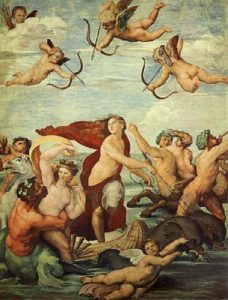
On 19 March 1885, in the Berliner Akademie der Wissenschaften, its presiding secretary Theodor Mommsen delivered the official speech to celebrate King and Emperor William I’s eighty-eighth birthday. The speech was entirely devoted to Sidonius Apollinaris and the Germanic peoples. Its moral lesson to the king: the Germanic invasions were not much of a success, ‘ein Weltreich zu gründen, ist nicht germanisch’, let us modestly further peace, for we know the alternative: ‘Wir wissen es, dass unsere ganze Nation durchdrungen ist von der Empfindung des ungeheuren Unglücks, welches über die Welt kommen würde, wenn also durch Ströme von Blut dieselbe zur einheitlichen Öde gemacht würde’.
Text in the Berlin Academy Archive
The poet and translator Karl Wolfskehl (1869-1948) admired Sidonius as is apparent from his correspondence while a refugee from Nazi Germany in New Zealand; see Karl Wolfskehls Briefwechsel aus Neuseeland 1938-1948, ed. Cornelia Blasberg, Darmstadt: Luchterhand, 1988, vol. 1, 150 and 287 (for English translation, see Poetry and Exile: Letters from New Zealand, 1938-1948, ed. Nelson Wattie, Lyttelton: Cold Hub Press, 2017):
… ich selber weise immer wieder auf den geistreichen und gewandt sich einordnenden, – fügenden und im Weine tröstenden Apollinaris Sidonius, dessen Epistolarium, hier hab oder find ich’s leider nicht, mir früher eine Lieblingsquelle fruchtbaren Genusses gewesen ist (Internet Archive).
… Aber auch Apollinaris Sidonius ist mein Liebling. Seine Briefe, so gallisch gewürzt und graziös in Wendung und Höflichkeit, sind dennoch voller Ernst und Würde und wie sehr ein Bild dieser Zeit gärenden und trächtigen Untergangs. … Des Apollinaris’ Gedichte nun erwecken meine ganz besondre Liebe. Einige über Wein und Weinbau hab ich in eigner Übertragung in mein “Buch vom Wein” eingereiht (Internet Archive; for these translation, see the Translations page).
I am grateful to William Direen from Dunedin, New Zealand, for pointing this out.
Playwright and stage director Hartmut Lange (born 1937, exiled from the DDR to West-Berlin in 1965), in his 1972 play Staschek oder das Leben des Ovid, on the dilemmas of compromising with the powers that be (casting Vergil and Horace in the role of cowardly court poets, and Ovid as a principled loner), has the protagonist meet Sidonius in Bordeaux instead of meeting Ovid in Tomi, as he expected. Staschek persuades Sidonius to smear his hair with rancid butter to assuage the barbarians. These, indeed, become nicer, but the stench makes Sidonius vomit repeatedly and prevents him from reciting his ode to Venus (cf. Carm. 12).
See Smolak 1980, 186-88, and 2008, 48-49; Theodore Ziolkowski, Ovid and the Moderns, Ithaca, NY: Cornell University Press, 2005, 133-36; ‘Ovid in the Twentieth Century’, in: Peter E. Knox (ed.), A Companion to Ovid, Malden, MA: Wiley-Blackwell, 2009, 455-68, esp. 460-61; ‘Ovid in Germany’, in: John F. Miller and Carole E. Newlands (eds), A Handbook to the Reception of Ovid, Malden, MA: Wiley-Blackwell, 2014, 386-400, esp. 394-95; Roman Poets in Modern Guise: The Reception of Roman Poetry since World War I, Rochester, NY: Camden House, 2020, 38-39 and 164.
Various
Hans E. Latzke, Auvergne, Tarn und Cevennen, DuMont Reise-Taschenbuch, 3rd ed., 2014, begins on p. 8:
‘”Dieses Land ist so schön, dass die Fremden selbst den Namen ihrer Heimat vergessen”, schrieb Apollinaris Sidonius, um 470 Bischof von Clermont, über die ins Land eingefallenen Westgoten.’
Claude Lopez-Ginisty, a Swiss Orthodox blogger, writes his own hymns for the Daily Offices. This one (23 August) invokes Sidonius:
Ton 1. Tropaire à saint Sidoine Apollinaire, évêque de Clarmont, natalice en 489 A.D.
Noble gaulois qui devins le préfet de Rome,
Fin poète et parent de l’empereur Avit,
Elu évêque par le peuple de Clermont,
Tu te consacras au troupeau de tes brebis,
En luttant contre l’infame hérésie arienne.
Saint Sidoine Apollinaire prie pour nos âmes!
This one (22 November) remembers Sidonius as a friend of Pragmatius:
Ton 2. Tropaire à saint Pragmace, évêque d’Autun, natalice en 520 A.D.
Evêque tu siégeas en la ville d’Autun.
Tu fus l’ami de saint Sidoine Apollinaire,
Et du hiérarque Avit en la cité de Vienne,
Tu participas aux grands Conciles des Gaules,
Et tu menas tes ouailles vers le Paradis.
Saint Pragmace, intercède auprès de Dieu pour nous!

